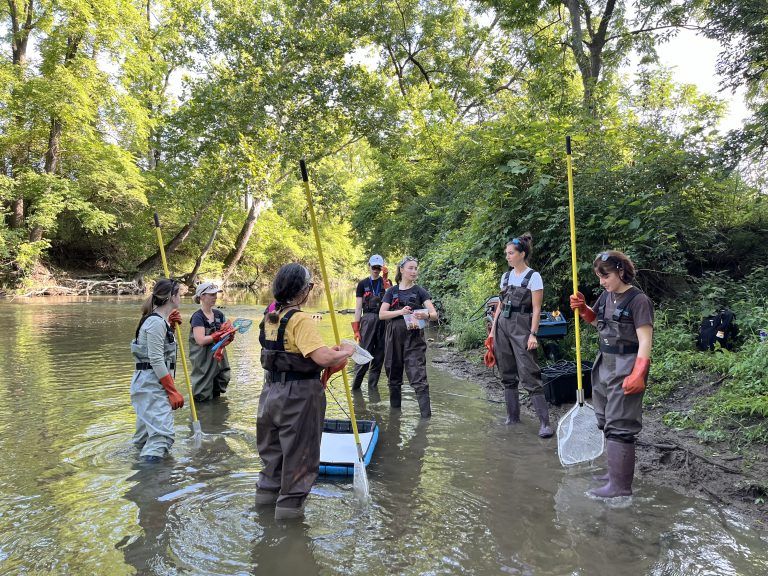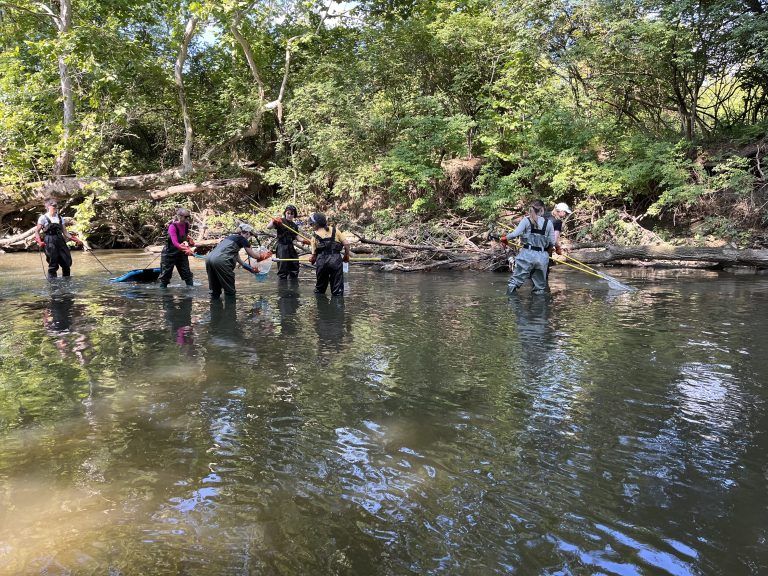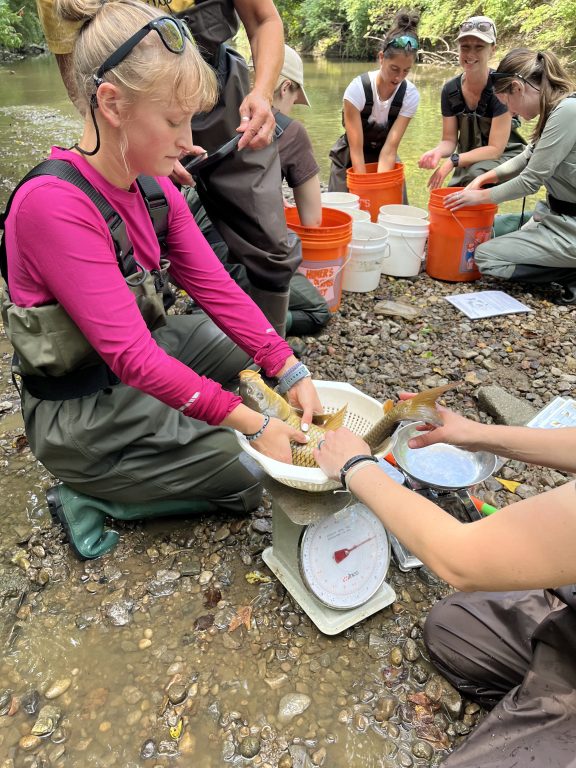This month ORF’s team of educators joined the Hamilton County Conservation District on Mill Creek to collect, identify, and learn about the fish living there. Mill Creek runs through over 450,000 people’s backyards and neighborhoods starting in Liberty Township and running south to downtown Cincinnati where Mill Creek flows into the Ohio River. Did you know at its origin Mill Creek is 797 feet above sea level and by the time it flows down to Cincinnati it has dropped 11.8 feet per mile to just 466 feet above sea level?! All roads (at least water roads) really do lead to the Ohio River.
Hamilton County Conservation District’s Public Involvement Coordinator, Sarah Meadows leads ORF educators in fish sampling on Mill Creek
Mill Creek runs through some of the most urbanized and industrialized areas in our region making it well-known for good and bad reasons. Unfortunately in the last 30 years, Mill Creek has been considered by many as one of the most polluted and physically degraded streams in the U.S. In the early 1990’s Ohio EPA found bacteria and viruses from raw sewage present throughout the creek as well as high levels of lead, heavy metals, organic compounds, pesticides, and ammonia all over acceptable federal and state pollution standards. Sediment in and surrounding the creek also had elevated levels of harmful metals. Combined sewer overflows poured into the creek along with runoff from urban neighborhoods and industry.
The few fish and macroinvertebrates that could survive these conditions were only the hardiest and pollution-tolerant species due to the poor water quality, but also because the stream had been channelized (artificially modified) in large sections and was nearly devoid of important native plants and trees all along the creek. The Ohio EPA still recommends that there be no public contact with the stream. (Today there are safe ways to paddle on the Mill Creek with proper precautions. Learn more here: https://www.
Fortunately, things have been changing for the better. The committed efforts of the Mill Creek Alliance, the Ohio EPA, Hamilton County Conservation District, local communities, and more have resulted in tremendous improvements which we saw firsthand when we went out to sample the fish species living in the Mill Creek.
Electrofishing in Mill Creek
Hamilton County Conservation District’s Public Involvement Coordinator, Sarah Meadows led us in electrofishing, a commonly used field sampling method, and we were quickly and easily able to collect and identify nine species of fish. Following Sarah’s careful instructions we worked together to place direct current electricity into the river causing nearby fish to be temporarily stunned. Using nets we collected the fish, identified and weighed them before quickly returning them to the river where they swam away. This method is preferred by scientists because it is the least biased method–unlike using nets which can make it hard to catch certain species of fish that may hide under rocks or be excellent evaders.
We found Common Carp, Longear Sunfish, Northern Hogsuckers, Smallmouth Bass, Yellow Bullhead catfish, Creek Chubs, and Striped Shiners. Although we did not complete a full and certifiable data collection process, the quick sampling we did gave us some great insight into the health of Mill Creek. Of the nine species found, three of those are fish species are classified as moderately intolerant to pollution, a very encouraging sign. To do a full scientific fish sampling and calculate the Index of Biotic Integrity we would take in many more factors than just the pollution sensitivity of a few fish species. Biotic Integrity is an integrated multimetric approach used to asses fish assemblages (the variety and abundance of fish species in a waterbody) and the integrity of surface waters.
Weighing a fish to help determine stream health
Other factors considered when doing a full fish study would be species diversity and richness (a count of individuals of each species), fish found at different levels of the food web (e.g. carnivores, herbivores, omnivores, insectivores, filter feeders, etc.), how they reproduce, and if there are any abnormalities found on individual fish such as parasites, infection, etc. In recent full calculations of the stream health of Mill Creek, it received an Index of Biotic Integrity score of 28 which places it in the middle of the fair category. There’s a lot of room for improvement and much more work to be done, but these fish are telling a hopeful story of resilience and recovery.
At the Ohio River Foundation, we work every day to improve the overall health and quality of all the small and large waterways that flow into the Ohio River. Educating the next generation about the importance of water quality and the power of science drives us. We offer excellent K-12 environmental programming to greater Cincinnati and Columbus schools to engage students in real-world science techniques, tools, and conservation. Our goal is to make science come alive and enjoyable for all types of learners. Thinking like a scientist is important for everyone in any field. Scientific thinking and understanding are crucial skills needed for every child’s future success.
Resources for Educators:
- Ohio River Foundation River Explorer Field Trips– Register your students for spring 2025 while space is still available.
- Ohio River Foundation Mussels in the Classroom– Register your students for the 2024-2025 school year. Plenty of space available fall, winter and spring.
- Ohio EPA Qualified Data Collector Level 1 Training for Educators- https://epa.ohio.gov/divisions-and-offices/environmental-education/training/level-one-qualified-data-collection
- US EPA- An Introduction to Freshwater Fishes as Biological Indicators- https://nepis.epa.gov/Exe/ZyPDF.cgi/P1002J1W.PDF?Dockey=P1002J1W.PDF



